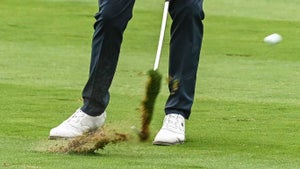Welcome to Play Smart, a regular GOLF.com game-improvement column that will help you play smarter, better golf.
Attack angle is a term that’s thrown around often as it pertains to the golf swing. And with good reason — it can tell us a ton about how you’re swinging the club.
For those unfamiliar with attack angle, here’s a quick refresher. Your attack angle is a measurement (in degrees) of the amount upward or downward your clubhead is traveling relative to the ground at impact. With the golf swing being an arc, your clubhead is either ascending, descending or at the low point, at the moment you hit the ball.
So, why does this all matter? Well, changing this number can have a huge impact on how you’re hitting the ball. For example, if you’re chunking the ball with your irons, you probably have an angle of attack that is too far downward. So when you’re hitting on a Trackman, you’d be looking at the attack angle and trying to change it so it isn’t quite so severe.
But changing your attack angle — as with any swing change — is easier said than done. It’s one thing to know what you’re supposed to change. It’s another thing to actually do it.
How to change your attack angle
So you’ve determined you need to change your attack angle. You’re headed to the range with a goal of altering those key numbers on the Trackman. Once you get there, though, you have no idea what you’re doing.
If you’ve brought a water bottle with you, you’re in luck. An empty water bottle can be one of the best — and cheapest — training aids you’ll ever use.
“That little sucker is a great training aid to sort your low point out and you attack angle,” says GOLF Top 100 Teacher Jonathan Yarwood.
All you need to do is place the empty water bottle on the ground in front of or behind your ball, all depending on what club you’re hitting.
Iron
With an iron, you want the attack angle to be more downward, with the low point in front of the ball, because you’re hitting down on it.
Place the water bottle about two grip lengths behind the ball, and then make a swing as you normally would. But on the way back and through, focus on not hitting the water bottle with your clubhead.
“You want the attack angle down and the low point forward,” Yarwood says. “You’re going to cover it much more with your chest than you are with your driver.”
As you make swings missing the water bottle, you’ll teach yourself to get the attack angle more downward and move the low point in front of the ball. This will help with your iron strikes and keep you from hitting behind the ball.
Driver
When hitting driver, you want to hit the ball on the upswing to maximize efficiency and power. This means getting the low point of your swing behind the ball and generating an upward angle of attack.
All you need to do with the water bottle is the exact opposite of what you’ve done with the iron. Place it a couple grip lengths in front of the ball this time and once again try not to hit it during your swing.
“You’ve got to really extend your [lead] side; you’ve got to tilt your head back; you’ve really got to get into this die bend position,” Yarwood says. “That will make the club start going upwards and starts hitting the ground [behind the ball].”
As you start missing the water bottle with your driver, you’ll see the low point of your swing moved back, your angle of attack going more upward, and your power and carry distance increasing.

